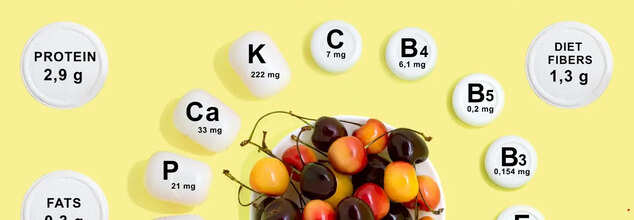- Health Conditions A-Z
- Health & Wellness
- Nutrition
- Fitness
- Health News
- Ayurveda
- Videos
- Medicine A-Z
- Parenting
- Web Stories
You Needs These 13 Vitamins To Function Properly Everyday

Credit: Canva
Vitamins are organic molecules that are essential for the body to function properly. Not only are they pivotal to cell growth but also their development and function. Harvard Health lists fruits, vegetables, whole grains, beans, legumes, low-fat proteins and dairy products as main sources of this essential nutrient.
Why Do We Need Vitamins?
Vitamins are essential for building a strong immune system, strengthening bones and skeleton, healing wounds and facilitating blood clotting. In addition, they also play a vital role in hormone regulation. Two particular vitamins, C and E function as antioxidants. Moreover, they also help the body get energy from food.
13 Vitamins You Need In Your Everyday Life
1. Vitamin A- Supports vision, especially in low light.
- Plays a crucial role in immune function and skin health.
2. Vitamin B1 (Thiamine)
- Helps convert carbohydrates into energy.
- Essential for nerve function and muscle coordination.
3. Vitamin B2 (Riboflavin)
- Aids in energy production and metabolism of fats, drugs, and steroids.
- Important for healthy skin, eyes, and nervous system.
4. Vitamin B3 (Niacin)
- Supports metabolism by helping convert food into energy.
- Plays a role in DNA repair and the production of stress hormones.
5. Vitamin B5 (Pantothenic Acid)
- Essential for the synthesis of coenzyme A, crucial for fatty acid metabolism.
- Supports the production of hormones and cholesterol.
6. Vitamin B6 (Pyridoxine)
- Involved in amino acid metabolism and the production of neurotransmitters.
- Aids in the formation of hemoglobin, which carries oxygen in the blood.
7. Vitamin B7 (Biotin)
- Plays a key role in fatty acid synthesis and glucose metabolism.
- Supports healthy hair, skin, and nails.
8. Vitamin B9 (Folate)
- Crucial for DNA synthesis and repair, and important during pregnancy for fetal development.
- Aids in red blood cell formation and helps prevent anemia.
9. Vitamin B12 (Cobalamin)
- Essential for nerve function and the production of DNA and red blood cells.
- Helps in the absorption of iron and supports brain health.
10. Vitamin C
- Functions as a powerful antioxidant, protecting cells from damage.
- Aids in collagen production, essential for skin, cartilage, and bone health.
11. Vitamin D
- Supports calcium absorption for healthy bones and teeth.
- Plays a role in immune function and reducing inflammation.
12. Vitamin E
- Acts as an antioxidant, protecting cells from oxidative stress.
- Supports immune function and skin health.
13. Vitamin K
- Essential for blood clotting and wound healing.
- Plays a role in bone metabolism and maintaining bone density.
What Is The Viral Cortisol Cocktail? Does It Really Work?

Credits: Canva
The internet is never out of trend, and for today, we have the trend of the viral Cortisol Cocktail. This one claims to actually help you with stress.
Not that we need to prove people that we are all experiencing a collective burnout that is making the Cortisol Cocktail trend, but just in case one needed to know, as per the Censis-Eudaimon Report, 31.8% of people feel close to burnout due to work stress.
Many reports, including the data from Mental Health Foundation that has published the stress statistics have also noted that more people are stressed than ever. In fact, we are more stressed than we look like. So it kind of makes sense when you see social media feed filled with hacks to bust your stress.
So, let's dive deep into this viral drink.
What Is A Cortisol Cocktail?
It is also known as the Adrenal Cocktail. It is a drink that has orange juice, coconut water, and salt as the main ingredient, among other ingredients. This claims to boost your energy, ease your stress, and also promote weight loss.
Through orange juice, you can get your vitamin C levels checked, coconut water provides you potassium, and salt is for sodium.
As per WebMD who spoke to Theodore C. Friedman, MD, PhD, professor of medicine at the UCLA School of Medicine and chief of the division of endocrinology, molecular medicine and metabolism at Charles R. Drew University, the adrenal glands are located right below our kidneys. They are responsible for producing more than 50 hormones, which also includes 'stress' hormones or cortisol and aldosterone, which maintains body's sodium balance. Thus this viral drink can boost the levels of sodium and help you energize your worn-out glands.
The Recipe To Release Your Stress
200 ml of coconut water
½ squeezed lemon
50 ml of orange juice
1 teaspoon of magnesium powder
¼ teaspoon fine salt
Sparkling water to taste
Why Are These Ingredients Important?
Coconut Water - Potassium
An estimated amount of 98% of potassium in your body is used and found in your cells. Once potassium is in your body, it works like an electrolyte and when it dissolves in water, it becomes positive or negative ions that can conduct electricity. Potassium ions carry positive charge and it helps to maintain fluid balance, sends nerve signals and regulates muscle contractions.
It is not an unknown fact that stress induces heart attack, panic attacks, and impacts cardiovascular health. This is where potassium does wonder. It helps lowering blood pressure, reduces water retention, and protects one against stroke. Cortisol release too can affect your electrolyte balance, and potassium can thus help balance it.
Orange Juice or Lemon - Vitamin C
Studies, including a 2020 study published in The Journal of Nutritional Biochemistry, titled The Role of Vitamin C in Stress-related Disorders, notes that vitamin C deficiency is widely associated with stress-related diseases. The ascorbic acid supplementation that is produced in vitamin C can work as antidepressant and enhance the mood.
Salt - Sodium
Too much of salt can in fact increase your stress and anxiety levels. A 2023 study published in Oxford Journals of Chemical Senses notes that licking of salt is associated with depression, stress, and anxiety. However, a pinch of it can help maintain the adrenal glands, as mentioned above.
Research from the University of Haifa published in the science journal Appetite has confirmed the relationship between salt and stress in humans. Researchers found an inverse correlation between salt and depression/stress, especially in women. In essence, the body is self-regulating to prevent stress and depression by making us crave salt.
New Texas Law Could Change Labeling Of Food Additives Across US

Credits: Canva & AP
A landmark move that could reshape how food products are labeled in the US will be taking place first in Texas. This is going to align the movement of Make America Healthy Again (MAHA), an off-shoot of Republican's Make America Great Again, an effort that focuses on making a healthy America by changing food and other lifestyle habits. While a lot under MAHA may not sit right with many people, including the vaccine backlash, but ensuring that people are aware of what they are consuming is the right way to do it.
Under this, Texas has become the first state to pass a law requiring warning labels on food and beverages that contain certain artificial dyes and additives. The legislation, signed into law by Republican Governor Greg Abbott, applies to over 40 commonly used food ingredients, including bleached flour, red dye 40, and yellow dye 50.
The decision has shaken the food industry and may have far-reaching consequences, and not just in Texas, but throughout the nation.
This is coming at the backdrop of RFK Jr's Food Dye Plan. Robert F Kennedy Jr has been a longtime critic of synthetic additives. He has, from time and again emphasized that Americans are consuming artificial chemicals without their knowledge or consent. "Four years from now, we are going to have most of these products off the market - or clearly labeled so you know what you are buying," he stated during a press briefing.
In April, the Trump administration announced its plan to phase out petroleum-based artificial food dyes from the US food supply. The Trump administration and the Department of Health and Human Services (HHS), headed by Robert F Kennedy Jr., described this as a "significant milestone".
What Is The New Law?
Under the new law, products sold in Texas that contain any of the specified dyes or additives must include a high-contrast warning label. The label will read:
“WARNING: This product contains an ingredient that is not recommended for consumption by the appropriate authority in Australia, Canada, the European Union, or the United Kingdom.”
This means that thousands of packaged foods—from cereals to snacks and beverages—may soon carry these warning labels if manufacturers don’t change their ingredients.
Why Is This A Landmark Move?
What makes this law stand out is not just its content but its origin. Until now, such health-driven food regulation had been the domain of more liberal states, such as California. Texas, a traditionally conservative state, taking this step signals a shift in how food safety is being approached across the political spectrum.
According to Scott Faber of the nonprofit Environmental Working Group, as also reported in the Washington Post, “When a state as big as Texas requires a warning, that will have an impact on the entire marketplace.”
It’s no small move. Texas has a massive consumer base, and most major food brands will find it difficult to ignore the state’s requirements. This could lead to sweeping changes in product formulations or labeling practices nationwide.
A Push For MAHA: Make America Healthy Again
As noted above, this new regulation is aligned with Health and Human Service Secretary RFK JR.'s MAHA agenda. The broader mission of MAHA is to reduce chronic disease and childhood illness through better health policies. That includes eliminating certain food additives that have been linked in other countries to health concerns.
Interestingly, support for the law in Texas came from both Democrats and Republicans—a rare bipartisan agreement in today’s political climate.
Republican State Senator Lois Kolkhorst, who sponsored the bill, said, “This is a national conversation about America’s health outcomes because we are spending more on health care than any other nation in the world.” She also shared that Kennedy had personally urged her to pass the bill.
However, the food industry is not happy with this law. The Consumer Brands Association, which represents major food companies, sent a letter to Governor Abbott urging him to veto the legislation. They argue that these additives are safe according to the U.S. Food and Drug Administration (FDA), which follows a science- and risk-based evaluation process.
Food & Medicine? Nutritionist Shares Tips That Could Help You Manage PCOS, Lower Blood Sugar And High BP Naturally

Credits: Canva
Your plate holds more power than you think. In a world overwhelmed by chronic conditions like PCOS, diabetes, and high blood pressure, the answer to feeling better may not lie in a prescription, but in the everyday meals we choose. As science increasingly affirms what traditional wisdom has long upheld, food isn’t just fuel, it’s one of the most effective tools we have for healing. Whether you're trying to balance hormones, manage blood sugar, or keep your blood pressure in check, eating with intention can dramatically shift the course of your health. And it starts with understanding that your next meal could be part of your medicine cabinet.
As chronic conditions like PCOS, diabetes, and high blood pressure become increasingly common in today’s fast-paced world, there is growing global interest in a therapeutic approach to eating—what experts call “food as medicine.” Modern nutritional science is now affirming age-old wisdom: the way we eat can have a profound impact on how we manage chronic health disorders. While medication and lifestyle changes are essential, food when chosen wisely—can serve as a powerful tool for healing, prevention, and long-term wellness.
We spoke to Manvi Agnihotri, Nutritionist, Health Expert, who emphasized the growing relevance of dietary strategies in addressing these common lifestyle disorders. “Food doesn’t just feed the body,” she said. “It helps recalibrate imbalances, support metabolic function, and even reverse the course of disease when paired with consistency and intention.”
Managing PCOS
Polycystic Ovary Syndrome (PCOS) is a complex hormonal condition marked by irregular menstrual cycles, insulin resistance, and inflammation. While the root causes vary, nutrition plays a foundational role in managing symptoms and supporting hormonal equilibrium.
Agnihotri highlights the importance of a low-glycemic index (GI) diet for women with PCOS. “Opting for foods that don’t cause sudden spikes in blood sugar can make a marked difference. Think whole grains like oats and quinoa, lentils, leafy greens, and good fats like avocado and nuts,” she says. These foods help regulate insulin levels, which are often elevated in PCOS patients and can worsen symptoms.
Equally important is avoiding inflammatory triggers. “Sugar, honey, jaggery, date syrup—all of these may sound natural, but they are high-GI and aggravate inflammation,” Agnihotri cautions. Even commonly consumed items like dairy, caffeine, and alcohol may need to be eliminated or reduced. “A lot of our everyday habits, like starting the day with tea or coffee, might unknowingly be fuelling our hormonal issues.”
Incorporating anti-inflammatory foods such as turmeric, berries, flaxseeds, and fatty fish can provide additional benefits. These not only support hormone regulation but also reduce oxidative stress and systemic inflammation, two key contributors to PCOS-related complications.
Diabetes and Diet
Managing diabetes especially Type 2, requires constant vigilance over blood sugar levels. But rather than resorting to highly restrictive diets, Agnihotri advocates for a balanced, mindful approach.
“Meals rich in fiber, lean protein, and healthy fats create a slow-release energy source that stabilizes glucose levels,” she says. Think sweet potatoes instead of white rice, lentils over refined flour, and nuts as snacks instead of processed chips. Portion control and meal timing also play crucial roles in preventing sudden spikes and crashes.
Staying hydrated and spacing meals evenly throughout the day is another simple but effective strategy. “Small, frequent meals help the body metabolize sugars more efficiently than long fasting periods,” Agnihotri notes.
Equally critical is monitoring HbA1c levels, a marker of long-term blood sugar control. According to the American Diabetes Association:
- HbA1c of 5.7–6.4% indicates prediabetes
- 6.5% or higher signifies Type 2 diabetes
- Below 5.7% is considered optimal
“The goal should be to stay below 5.7% consistently,” Agnihotri advises, “and that begins with food—smart, intentional food.”
Lowering High Blood Pressure
Hypertension, often dubbed the “silent killer,” rarely presents symptoms in its early stages yet significantly raises the risk of heart disease and stroke. Fortunately, dietary changes can be a front-line defense.
The DASH diet (Dietary Approaches to Stop Hypertension) remains a gold standard. “It’s rich in potassium, magnesium, and fiber,” explains Agnihotri. “That means more fruits, vegetables, whole grains, and lean proteins—while cutting back on salt and processed foods.”
Simple food swaps can have substantial effects: bananas for potassium, spinach for magnesium, beetroot for nitric oxide, and garlic for its natural vasodilatory effects.
Agnihotri emphasizes the importance of label reading: “Just because something is marketed as ‘low fat’ or ‘heart healthy’ doesn’t mean it’s low in sodium or free from harmful preservatives. Awareness is half the battle.”
Why Nutritional Customization Is Important?
There is no one-size-fits-all formula in dietary therapy. Genetics, lifestyle, underlying conditions, and even cultural preferences can influence what diet works best for an individual.
“Personalized nutrition is the future,” says Agnihotri. “What works for someone with PCOS may not work for someone with diabetes. But the foundational principle is the same—choose whole, anti-inflammatory, nutrient-dense foods, and avoid what causes damage.”
She strongly recommends working with a certified nutritionist to develop a tailored eating plan that suits your unique metabolic needs and health goals. “Don’t self-diagnose or rely solely on social media trends,” she warns. “Your body is your best guide, learn to listen to it.”
Food should not be viewed simply as fuel, it is a daily prescription for health. When selected mindfully and consumed consistently, the right foods can support hormone health in PCOS, regulate blood sugar in diabetes, and keep blood pressure in check.
The key lies not in restriction but in restoration—reclaiming control over one’s health through educated, empowered eating. As Manvi Agnihotri puts it, “It’s not about a strict diet. It’s about sustainable, nourishing habits that help you feel better every day.”
From balancing blood sugar to calming inflammation, managing stress hormones to regulating cardiovascular risk—your plate has the power to heal. Let it.
© 2024 Bennett, Coleman & Company Limited

